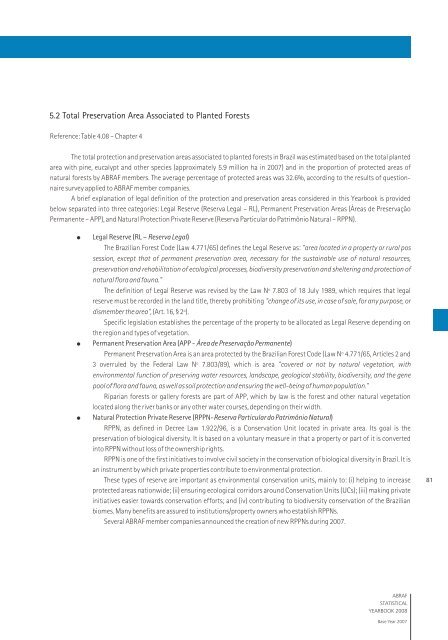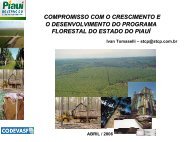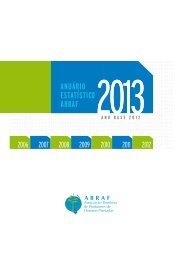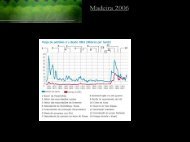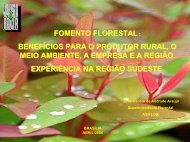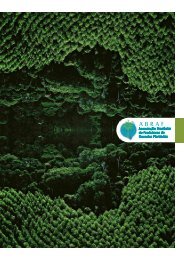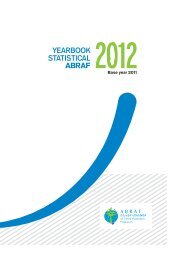ABRAF STATISTICAL YEARBOOK - Associação Brasileira de ...
ABRAF STATISTICAL YEARBOOK - Associação Brasileira de ...
ABRAF STATISTICAL YEARBOOK - Associação Brasileira de ...
You also want an ePaper? Increase the reach of your titles
YUMPU automatically turns print PDFs into web optimized ePapers that Google loves.
5.2 Total Preservation Area Associated to Planted ForestsReference: Table 4.08 – Chapter 4The total protection and preservation areas associated to planted forests in Brazil was estimated based on the total plantedarea with pine, eucalypt and other species (approximately 5.9 million ha in 2007) and in the proportion of protected areas ofnatural forests by <strong>ABRAF</strong> members. The average percentage of protected areas was 32.6%, according to the results of questionnairesurvey applied to <strong>ABRAF</strong> member companies.A brief explanation of legal <strong>de</strong>finition of the protection and preservation areas consi<strong>de</strong>red in this Yearbook is provi<strong>de</strong>dbelow separated into three categories: Legal Reserve (Reserva Legal – RL), Permanent Preservation Areas (Áreas <strong>de</strong> PreservaçãoPermanente – APP), and Natural Protection Private Reserve (Reserva Particular do Patrimônio Natural – RPPN).Legal Reserve (RL – Reserva Legal)The Brazilian Forest Co<strong>de</strong> (Law 4.771/65) <strong>de</strong>fines the Legal Reserve as: "area located in a property or rural possession, except that of permanent preservation area, necessary for the sustainable use of natural resources,preservation and rehabilitation of ecological processes, biodiversity preservation and sheltering and protection ofnatural flora and fauna."The <strong>de</strong>finition of Legal Reserve was revised by the Law Nº 7.803 of 18 July 1989, which requires that legalreserve must be recor<strong>de</strong>d in the land title, thereby prohibiting "change of its use, in case of sale, for any purpose, ordismember the area", (Art. 16, § 2º).Specific legislation establishes the percentage of the property to be allocated as Legal Reserve <strong>de</strong>pending onthe region and types of vegetation.Permanent Preservation Area (APP - Área <strong>de</strong> Preservação Permanente)Permanent Preservation Area is an area protected by the Brazilian Forest Co<strong>de</strong> (Law Nº 4.771/65, Articles 2 and3 overruled by the Fe<strong>de</strong>ral Law Nº 7.803/89), which is area "covered or not by natural vegetation, withenvironmental function of preserving water resources, landscape, geological stability, biodiversity, and the genepool of flora and fauna, as well as soil protection and ensuring the well-being of human population."Riparian forests or gallery forests are part of APP, which by law is the forest and other natural vegetationlocated along the river banks or any other water courses, <strong>de</strong>pending on their width.Natural Protection Private Reserve (RPPN-Reserva Particular do Patrimônio Natural)RPPN, as <strong>de</strong>fined in Decree Law 1.922/96, is a Conservation Unit located in private area. Its goal is thepreservation of biological diversity. It is based on a voluntary measure in that a property or part of it is convertedinto RPPN without loss of the ownership rights.RPPN is one of the first initiatives to involve civil society in the conservation of biological diversity in Brazil. It isan instrument by which private properties contribute to environmental protection.These types of reserve are important as environmental conservation units, mainly to: (i) helping to increaseprotected areas nationwi<strong>de</strong>; (ii) ensuring ecological corridors around Conservation Units (UCs); (iii) making privateinitiatives easier towards conservation efforts; and (iv) contributing to biodiversity conservation of the Brazilianbiomes. Many benefits are assured to institutions/property owners who establish RPPNs.Several <strong>ABRAF</strong> member companies announced the creation of new RPPNs during 2007.81<strong>ABRAF</strong><strong>STATISTICAL</strong><strong>YEARBOOK</strong> 2008Base Year 2007


